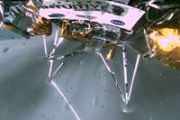
Copernical Team
SpaceX Saturday Starlink launch on schedule
 SpaceX is scheduled to launch its Falcon 9 rocket Saturday, which will deliver 24 Starlink satellites into low Earth orbit.
Liftoff from launch site SLC-4E at Vandenberg Space Force Base in California remained on schedule Saturday morning, with ignition expected to occur at 1:55 p.m. EDT, SpaceX confirmed on its launch schedule page.
The California-based space technology company'
SpaceX is scheduled to launch its Falcon 9 rocket Saturday, which will deliver 24 Starlink satellites into low Earth orbit.
Liftoff from launch site SLC-4E at Vandenberg Space Force Base in California remained on schedule Saturday morning, with ignition expected to occur at 1:55 p.m. EDT, SpaceX confirmed on its launch schedule page.
The California-based space technology company' SpaceX launches cargo freighter to the International space Station
 SpaceX launched the latest in a series of cargo freighter missions to the International Space Station Sunday evening from Florida's Cape Canaveral Space Force Station.
The Northrop Grumman NG-23 Cygnus XL was launched at 6:11 p.m. EDT into low-Earth orbit atop a SpaceX Falcon 9 rocket, shuttling supplies and experimental equipment to the ISS.
The mission, hauling 11,000 pounds of
SpaceX launched the latest in a series of cargo freighter missions to the International Space Station Sunday evening from Florida's Cape Canaveral Space Force Station.
The Northrop Grumman NG-23 Cygnus XL was launched at 6:11 p.m. EDT into low-Earth orbit atop a SpaceX Falcon 9 rocket, shuttling supplies and experimental equipment to the ISS.
The mission, hauling 11,000 pounds of Graphene reveals light tuned quantum states pointing to new electronics
 Researchers have pushed graphene's promise further by directly observing Floquet effects in the one-atom-thick carbon lattice, confirming that Floquet engineering can precisely tune metallic and semi-metallic quantum materials. The international effort was led by the University of Goettingen with collaborators in Braunschweig, Bremen, and Fribourg, and the findings appear in Nature Physics.
Researchers have pushed graphene's promise further by directly observing Floquet effects in the one-atom-thick carbon lattice, confirming that Floquet engineering can precisely tune metallic and semi-metallic quantum materials. The international effort was led by the University of Goettingen with collaborators in Braunschweig, Bremen, and Fribourg, and the findings appear in Nature Physics. Deep Fission secures $30M to advance underground nuclear reactors
 Deep Fission Inc, a nuclear technology company developing small modular pressurized water reactors deployed in boreholes one mile underground, has raised $30 million in a private placement at $3.00 per share and completed a reverse merger with Surfside Acquisition
Deep Fission Inc, a nuclear technology company developing small modular pressurized water reactors deployed in boreholes one mile underground, has raised $30 million in a private placement at $3.00 per share and completed a reverse merger with Surfside Acquisition Boeing accelerates spacecraft production with 3D-printed solar panel structures
 Boeing has introduced a 3D-printed solar array substrate design that cuts composite build times by as much as six months for a typical solar wing assembly, representing up to a 50 percent faster production cycle compared with current methods.
The company has already completed engineering tests on flight-ready hardware and is moving through standard qualification steps ahead of operational
Boeing has introduced a 3D-printed solar array substrate design that cuts composite build times by as much as six months for a typical solar wing assembly, representing up to a 50 percent faster production cycle compared with current methods.
The company has already completed engineering tests on flight-ready hardware and is moving through standard qualification steps ahead of operational Asteroid tells secrets of Earth's 'far wetter' building blocks
 Earth's building blocks were "far wetter" than previously imagined, new analysis of tiny samples from a distant asteroid has suggested, overturning long-held assumptions about the early solar system.
Research on a tiny portion of the 5.4 grams of rock and dust collected from the Ryugu asteroid, some 300 million kilometres (185 million miles) from Earth, offers new insights into how the solar
Earth's building blocks were "far wetter" than previously imagined, new analysis of tiny samples from a distant asteroid has suggested, overturning long-held assumptions about the early solar system.
Research on a tiny portion of the 5.4 grams of rock and dust collected from the Ryugu asteroid, some 300 million kilometres (185 million miles) from Earth, offers new insights into how the solar Satlink joins Rivada to deliver secure satellite connectivity for defense and enterprise
 Satlink, a Madrid-based provider of satellite telecommunications, has formed a partnership with Rivada Space Networks to deliver advanced connectivity solutions designed for Spain's defense and enterprise sectors. Rivada has already secured more than $17 billion in global business commitments for its planned low Earth orbit (LEO) constellation.
Established in 1992, Satlink supplies satelli
Satlink, a Madrid-based provider of satellite telecommunications, has formed a partnership with Rivada Space Networks to deliver advanced connectivity solutions designed for Spain's defense and enterprise sectors. Rivada has already secured more than $17 billion in global business commitments for its planned low Earth orbit (LEO) constellation.
Established in 1992, Satlink supplies satelli ICEYE unveils ISR Cell to deliver space intelligence at tactical scale
 ICEYE, a global leader in Synthetic Aperture Radar (SAR) satellite services, has introduced the ISR Cell, a containerized system that gives defense organizations direct, on-site access to tactical Intelligence, Surveillance and Reconnaissance (ISR) from space in near-real-time. The new unit is designed to accelerate decision-making in high-risk environments by shifting satellite intelligence fro
ICEYE, a global leader in Synthetic Aperture Radar (SAR) satellite services, has introduced the ISR Cell, a containerized system that gives defense organizations direct, on-site access to tactical Intelligence, Surveillance and Reconnaissance (ISR) from space in near-real-time. The new unit is designed to accelerate decision-making in high-risk environments by shifting satellite intelligence fro First Tranche 1 satellites launched for Space Development Agency network
 Space Systems Command's Assured Access to Space has successfully placed 21 Proliferated Warfighter Space Architecture (PWSA) Transport Layer satellites into orbit, marking the first launch of Tranche 1 from Vandenberg Space Force Base, California. The mission, supported by Space Launch Delta 30, flew aboard a SpaceX Falcon 9 and delivered York Space Systems-built data transport satellites.
Space Systems Command's Assured Access to Space has successfully placed 21 Proliferated Warfighter Space Architecture (PWSA) Transport Layer satellites into orbit, marking the first launch of Tranche 1 from Vandenberg Space Force Base, California. The mission, supported by Space Launch Delta 30, flew aboard a SpaceX Falcon 9 and delivered York Space Systems-built data transport satellites. For too long, colonial language has dominated space exploration: Is there a better way?
This request seems a bit unusual, so we need to confirm that you're human. Please press and hold the button until it turns completely green. Thank you for your cooperation!
Press and hold the button
If you believe this is an error, please contact our support team.
185.132.36.159 : 78665aa8-a3c8-433c-9e05-bc38ec6d



































